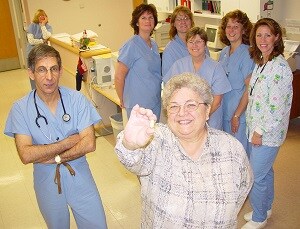Breakthrough Diagnostics In A Pill
 When Anita Lachance of Franklin heard she could swallow a pill which would photograph her small intestine, she thought it sounded like something out of Star Trek, but the idea sounded much more attractive than yet another invasive test. Her friend had successfully undergone the procedure and Ajay K. Batra, M.D., of Milford Gastroenterology Associates, Inc., hoped it might shed light on Anita’s condition as well.
When Anita Lachance of Franklin heard she could swallow a pill which would photograph her small intestine, she thought it sounded like something out of Star Trek, but the idea sounded much more attractive than yet another invasive test. Her friend had successfully undergone the procedure and Ajay K. Batra, M.D., of Milford Gastroenterology Associates, Inc., hoped it might shed light on Anita’s condition as well.
Since her blood counts had been dropping and other medical tests failed to pinpoint the cause, Anita was a perfect candidate for capsule endoscopy, a state-of-the-art procedure that has led to exciting new developments in the gastroenterology specialty. Anita went to Milford Regional Medical Center’s endoscopy suite, where sensors were applied to her abdomen and a walkman-like data recorder belted to her waist. She swallowed the vitamin-sized PillCam SB (small bowel) capsule, which had its own camera and light source. After about a half hour of preparation, Anita returned home and went about her day. Meanwhile, the video capsule traveled through her body and images were transmitted to the data recorder.
“It’s amazing; you swallow the pill, go home, and come back in eight hours to give them the recorder,” said Anita. “There’s no discomfort, and you get answers without going through a difficult procedure.”
The FDA approved the PillCam SB in 2001. Dr. Batra said that Milford Gastroenterology Associates has used it for the last couple of years, doing four to five studies per month. The capsule endoscopy technique enables doctors to examine the three portions of the small intestine.
“It’s a relatively simple and ingenious way of looking at the small intestine, which in the past was really hard to view,” said Dr. Batra. “It’s done physiologically without a scope putting air in and distending the bowel. With the pill, it passes through like food and is shown to be better tolerated by the patient and more accurate than other methods. It’s a big pill, but generally people swallow it without any problem. It’s usually excreted in a bowel movement in about eight hours — the patient might not even notice.”
Dr. Batra said the PillCam SB takes two pictures per second, or about 55,000 per study. Afterwards, it is downloaded via computer software and converted into a color video viewed by the physician. It generally takes about 90 minutes to review the video, said Dr. Batra.
“The test is mainly used for obscure gastrointestinal bleeding, when there are signs that someone is losing blood from the GI tract,” said Dr. Batra. “A patient could be having unexplained anemia, seeing bloody or black tarry bowel movements, and/or have weakness, fatigue, fever, diarrhea and abdominal pain. Causes could be polyps, tumors, Crohn’s disease, ulcerations or arteriovenous malformations (AVMs), situations which can range in severity from being a nuisance to life-threatening.”
In some cases, a patient might need medical therapy, radiological therapy or surgical intervention after the diagnosis, while in other cases closer monitoring might be recommended. Dr. Batra said the most common finding is AVMs, collections of small blood vessels that may develop in various parts of the digestive system.
Despite the advantages of the PillCam SB, Dr. Batra said it doesn’t replace colonoscopies or upper endoscopies as it doesn’t photograph the entire gastrointestinal tract or the site of colon cancer. In fact, it’s rarely the first step; however, it could prove valuable down the line if the patient still needs further testing, he said.
“It’s non-invasive, provides information we’ve never been able to easily get before; it’s relatively low risk, and it has a fairly high yield of information that can change how we would treat something,” said Dr. Batra.
Although the FDA has approved a similar technique to view the esophagus and detect conditions, such as Gastroesophageal Reflux Disease, Dr. Batra thinks more benefits need to emerge before Milford Regional considers it as a diagnostic tool. He believes that conventional endoscopy is more efficient for examining the esophagus as the doctor can take biopsies, perform treatments and move the scope back and forth.
“I do think that capsule endoscopy will continue to expand in its use,” said Dr. Batra.
In the meantime, Anita Lachance was grateful that capsule endoscopy provided answers for her condition. Although she had to fast overnight and restrict her diet until the study ended, Anita didn’t mind — considering the stringent fasting requirement of many other tests. Nor did she mind swallowing the capsule, which was similar in size to her calcium and iron pills. Her diagnosis was AVMs, and thus far, the action plan has been continued monitoring with monthly blood work and iron pills.
“The test didn’t faze me at all,” she said. “I thought it was tremendous. Now, I really know science fiction firsthand.”
For more information on the PillCam SB or other gastrointestinal concerns, call Milford Gastroenterology Associates, Inc. at 508-478-6363.
Go to In Their Own Words